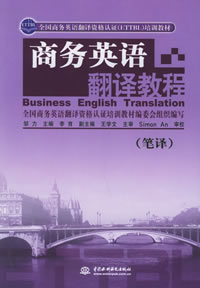翻译课上学语言
作者:古龙 2009-07-04




语际翻译公司 转载请注明https://www.scientrans.com
∗本栏目部分文章内容来自互联网,部分已经过本站编辑和整理,如有版权事宜请联系Email/MSN jesczhao@hotmail.com
Language Learning in Translation Classrooms
"Learning is a social process that occurs through interpersonal interaction within a cooperative context. Individuals, working together, construct shared understandings and knowledge."
David Johnson, Robert Johnson, and Karl Smith. Active Learning: Cooperation in the College Classroom.
Edina, Mn: Interaction Book Co., 1991.
I haven't heard it recently, but there was a time when it was common to hear people say, "those who can, do; those who can't, teach." Perhaps this saying has lost its appeal because first of all more and more educators have realized the advantages students reap when professionals add their competence to the academic framework. Second, there are many people both working in their fields and teaching in a university setting. Prominent translation trainers such as Gouadec, Kiraly and Pym have emphasized the advantages of work-simulated translation classes; professionals are the logical instructors in such programs (Gouadec: 1999; Kiraly: 1995; Pym: 2002).
Although practicing translators and interpreters are not in the classroom to learn, one of the major benefits to teaching is definitely how much teachers do learn about the complexity of the learning process by supporting student efforts to become competent professionals. One of the common errors that new instructors at university make however is to assume that their students are already expert learners. Because university students are adults, many instructors presume that their own role consists of presenting material once, applying it briefly and then moving on to a new concept. They often assume students are able to apply newly acquired concepts in foreign situations after having been exposed only briefly. However, this may not be the case. In reality, each classroom is made up of a set of individuals with their own backgrounds, learning styles and academic levels. Translation professionals preparing to share their techniques and experience with students will find it helpful to review the basic ways it is believed that students learn. This article explores learning approaches applicable to translation instructors whose goal it is to improve their students' language learning competence. Bob Hodge in Teaching as Communication (1993) stated that "language, above all, holds a community together" (p. 2). Even though children learn a language implicitly, people who use languages as the tools of their professions, such as translators and interpreters, must learn languages much more deeply than others. Although the discussion of how people learn is still a very controversial subject, those approaches that follow may be particularly applicable to adult learners.
One of the roles of a psychologist is to investigate the way people learn. One of the most influential explanations has been the behaviorist approach. An instructor who uses this approach would break up knowledge into small, logically organized pieces of information and provide positive reinforcement so that students learn to use that information. Behaviorists emphasize repetition of material so that it becomes a natural reaction for the student. Behaviorism has fallen from favor somewhat recently with the broadly held belief today that learning is a complex activity involving more than just repetition. However, language students and students who use language do benefit from a certain amount of well thought-out repetition and the use of models as a basis for their writing.
A more recent explanation of how to encourage learning, the cognitive approach, is quite appropriate to university teaching as it recognizes that learning is not only the recall of facts but also involves memory, reasoning, critical thinking and problem solving, all of which are applicable to the daily activities of a translator or interpreter. According to Svinicki in Memory Enhancement (1997), six principles of cognitive learning can be directly applied to learning.
1. Students must see the information to be learned as important to their lives.
Implication: the instructor must show the students how this information is beneficial.
2. During learning, learners act on information to make it more meaningful.
Implication: Instructors and students should clarify information through examples, images, elaborations and links to prior knowledge.
3
- 评论
- seme:文章内容文章内容文章内容文章内容文章内容文章内容文章内容文章内容文章内容 章内容文章内容文章内容文章内容文章内容
- seme:文章内容文章内容文章内容文章内容文章内容文章内容文章内容文章内容文章内容 章内容文章内容文章内容文章内容文章内容

- 谈翻译观念的嬗变与翻译技能的训练
2009-6-15 15:33:10 - 《高等学校英语专业英语教学大纲》中规定,大学生通过四年的在校学习,“能运用翻译的理论和技巧,将英美报刊上的文章以及文学原著译成汉语,或将我国报刊、杂志上的文章和一般文学作品译成英语……。译文要求忠实...
- 翻译与网络营销
2009-6-11 0:02:31 - Translation and Your International E-Commerce Strategy Most businesses realize that they ...
- 第四届IEEE生物信息与生…
2009-6-30 19:42:01 - 基本信息 主办单位: 四川大学,IEEE生物医学工程协会(EMBS) 承办单位 开始日期 2010/06/18 结束日期 截稿日期 2009/1...
- 第九届全国光电技术学术…
2009-6-30 19:35:58 - 基本信息主办单位: 中国宇航学会光电技术专业委员会承办单位 开始日期 2009/11/01结束日期 截稿日期 2009...
















